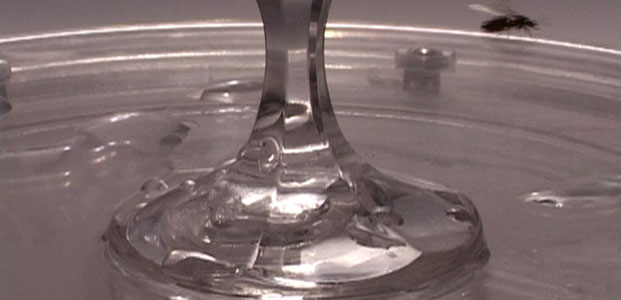'SCHWANKENDE
PERSPEKTIVEN'
video programme curated by Emilie Bujes and Elsa de Seynes
Saturday, 3 November, 2007, 9 p.m.

KEREN
CYTTER, Dreamtalk, 2005, 11', digital video, color/sound.
KEREN CYTTER, Nothing, 2003, 13', digital video/8 mm , color/sound.
VERONIKA GERHARD, A Night In Hawaiian Royal, 2004, 4'41'', digital video,
color/sound.
VERONIKA GERHARD, Rendez-vous Entre Chien et Loup_Entre Chien et Loup:
Twilight, 2003, 7'37'', digital video, color/sound.
CATARINA SIMOES, The Home Planet, 2006, 7'40, digital video, color/sound.
Historically, experimental film has always wanted to reject the conventions of narrative cinema. On the other hand, art and cinema constantly inspired and influenced each other. Keren Cytter, Veronika Gerhard and Catarina Simões seem to use narratives that belong to the cinematic language; they actually sabotage, from inside, the very structures they appropriate. Experimentation on text and on storytelling is the recurrent element in the selected films; the superimpositions of narrative layers and the investigation of the narrator's role are some of the methods they employ. Pseudo-fiction, pseudo-science fiction, pseudo-reality TV, pseudo-science... through their stories, they purposefully lead the viewer on the wrong tracks and allow her/him to question the perception she/he has of reality and truth conveyed by narratives. Not only their conscious allusion and derision of codes in film and TV point at social tendencies, but also reveal the artists' presence.
Dreamtalk is emblematic of Keren Cytter's manner, filled with
clichés -which she praises- and euphoria. Three people, recalling
soap-opera actors, are eating and watching Reality TV. Their story seems
to match the TV show's plot, thus highlighting the artificiality of the
situation. Besides the intentional bad acting, the rapid rhythm of editing
together with the slight de-synchronization between image and sound, reveal
a homemade production. Once again, Keren Cytter applies social mechanisms
and scripts, which she systematically destroys.
Her second film Nothing is a multiplication of semantic layers: the character's perceptions viewed through those of the filmmaker. Through the use of other formats (text, drawings, Super 8 film), story fragments collide and disappear. However, the "organising element" (as the artist describes herself) operates on a different level, which results in this case, in a rather cinematic, less experimental movie.
In A Night In Hawaiian Royal, a slightly high-pitch accelerated "female" voice-over shares her impossibility in fulfilling the narrative role of the "I". Through the plagiatory practice of a post-structuralist feminist text; abstract theoretical thoughts are turned into an internal monologue of the self. In the the form of a videodiary -and with a certain sense of humour, Veronika Gerhard experiments with changes of perspectives in her attempt to represent the "I".
Rendez-vous Entre Chien et Loup_Entre Chien et Loup: Twilight imitates the narrative and visual codes of the documentary wildlife TV program to report on a capitalist authoritarian society, which ideology rests on a biological revolutionary discovery. While recounting its pseudo-scientific past developments, the artist abruptly interrupts the visual narration, making the storytelling hers. In both works, Veronika Gerhard addresses the political dimension of narratives and questions the truth ascribed to the deployment of information and knowledge within contemporary society.
"While seeing her studio being pestered by ants, Catarina Simões became aware of the insects' dystopian potential and decided to turn their characteristics into character traits." (Catarina Simões)
In The Home Planet, Catarina Simões pushes the artifice to the extreme not only through the monologue, made of cut-ups from science fiction novels, which mixes different viewpoints, but also through the setting imagined by the artist - a tower constructed with glasses recalling the set-ups of early science-fiction films. The banal occurrence, transfigured by an aesthetics close to advertising photography, is confronted to the "extra-ordinary" story (sound-wise) and in turn derisively trivialized by the ants.
We decided to present the works in a gallery space but within a cinematic temporality –with a beginning and an end.
_______________
Keren Cytter had a solo show at KW Institute for Contemporary Art, Berlin, and won the Baloise-Art Prize, Art Basel, Switzerland, in 2006. This year, she presented her works in solo shows at MUMOK, Museum Moderner Kunst Stiftung Ludwig, Vienna, Elisabeth Kaufmann, Zurich, Thierry Goldberg Projects, New York and in the following group exhibtions/screenings: Self Fashioned Show, Extra City, Antwerpen, Lyon Biennial and 2nd Moscow Biennial.
Catarina Simões had solo shows at Starship Magazine e.V., Berlin, 2007 and at the Museu do Chiado, National Contemporary Art Museum, Lisbon, 2006. She also participated to the group exhibition SCIENCE I FICTION, Galerie Metro, Berlin, 2007.
Veronika Gerhard was Artist in Residence of the City of Paris, Cite International des Arts, Paris, in 2004, took part to the artist Studio Program, SSamzie Space, Seoul, Korea, 2003, and to Documenta Education Project, Scholarship of Documenta 11, Kassel, Germany, 2002. She presented her films at the Open Space Festival of Free Arts, Berlin in 2007, the Art Film Biennale, Museum Ludwig, Cologne 2005 and at Kunstwerke, Institute for contemporary Art, Berlin in 2003.
_______________
After a common working experience at the art TV channel ikono.tv, Emilie Bujes and Elsa de Seynes started to collaborate on video programs, which they presented at the off-space POST in Berlin. Emilie Bujes worked then at the Centre d'Art Contemporain of Geneva, while contributing further to the art review vonhundert. Lately, she curated a program for the experimental short category at the LUFF Festival in Lausanne. Elsa de Seynes produced the shortfilm of Berlin-based French filmmaker Yves Lechermeier. Now respectively working at Centre Pompidou, Paris, and at the Haus der Kulturen der Welt, Berlin, Emilie Bujes and Elsa de Seynes meet again to present the program "Schwankende Perspektiven" at Galerie Olaf Stüber.